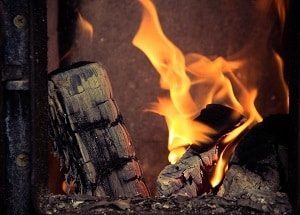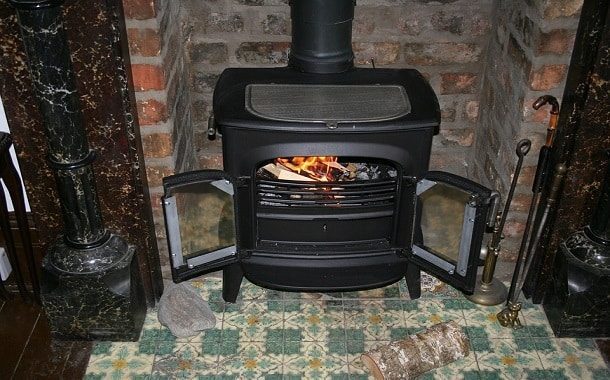How Much Does a Wood Stove Cost?
Last Updated on February 18, 2024
Written by CPA Alec Pow | Content Reviewed by ![]() CFA Alexander Popinker
CFA Alexander Popinker
Investing in a wood stove can provide an affordable and eco-friendly way to heat your home. But what exactly is the cost of buying and installing a wood stove?
This guide examines the wood stove prices, installation costs, and operating expenses to consider when budgeting for this cozy heating solution.
Installing a wood-burning stove offers the warmth and charm of a fireplace combined with practical space-heating abilities. Wood stoves have evolved into highly efficient heating systems that burn clean and provide reliable warmth for the home.
While stoves require an initial upfront investment, they can save money in the long run by offsetting high heating bills.
Before purchasing a wood stove, it’s important to understand the range of costs involved. We will look at the key factors affecting wood stove costs so you can find the best stove option within your budget.
How Much Does a Wood Stove Cost?
The cost of a wood stove can vary quite a bit depending on the size, style, and features you choose. Basic models start around $500-800, while high-end wood stoves with the latest technology can cost $2,500-5,000.
According to Houzz, the typical cost for a new wood stove installation is $2,000–$4,000, with high-end projects costing upward of $5,000.
Remodeling Calculator writes that wood-burning stove installation starts from $5,000, excluding chimney installation, which can add another $2,000-$3,000 to the price.
The average price for a complete wood-burning stove installation is around $3,000, which includes chimney and ventilation expenses as well.
Homewyse notes that the cost to clean a wood stove starts at $138–$176 per stove.
Types of Wood Stoves
The most budget-friendly options are basic freestanding wood stoves constructed from steel or cast iron. Expect to pay $800-1500 for a standard freestanding wood stove.
Fireplace inserts that are designed to fit inside existing fireplaces tend to cost slightly more, ranging from $1,000-2,000 on average.
EPA-certified wood stoves, which meet stricter emissions standards for clean burning, are on the higher end starting around $1,500 or more.
For a top-of-the-line wood stove with high-tech features and customized designs, expect to invest $3,000-5,000 or beyond.
Efficiency and Heating Capacity
More efficient wood stoves with higher BTU outputs for heating larger spaces will be priced at the higher end of the spectrum. Basic wood stoves produce between 10,000-40,000 BTUs, while larger stoves provide 60,000 BTUs or greater.
High-efficiency wood stoves, which extract more heat from the wood fuel, typically cost $2,000 or more.
Materials and Construction
The main materials used for wood stove construction also impact cost.
- Cast iron wood stoves are the most traditional option, retain heat well, and start around $1,000.
- Steel stoves are often more affordable at $600-1,000.
- For a more decorative look, soapstone stoves made from natural stone cost $1,500-3,000.
- Enamel-coated steel offers an upscale look for $1,500-2,500.
Top Brands
Well-known brands like Jøtul, Vermont Castings, and Morso offer premium wood stoves ranging from $1,500 up to $4,000 or more for high-end models.
Installation Costs for Wood Stoves
On top of the stove purchase price, you will need to budget for professional installation. This includes labor, materials for venting and chimney modifications, permits, and inspection fees.
The average cost to hire an expert to install a wood stove ranges from $1,500-3,000. Simple installations could start around $500, while extensive chimney work or installations through exterior walls could cost up to $5,000. Get multiple quotes to find the best rate.
Chimney Installation
If you don’t have an existing chimney, installing a new stovepipe and chimney could add $2,000 or more to your total budget. Chimney installation costs depend on:
- Type of chimney required (e.g. masonry, metal, double/triple wall pipe)
- Whether chimney components are insulated
- The height of chimney needed
- Whether exterior wall penetration is needed
Wood stove venting costs including roof and wall pass-throughs average $300-$500 in additional fees.
Professional Certifications
Be sure to hire an installer certified by the Chimney Safety Institute of America to ensure proper code compliance. Some areas also require installers to have an EPA certification for wood-burning stoves. Checking for the right permits and inspections can add $150 or more.
DIY Installation
Opting for a DIY wood stove installation can save on labor fees, but make sure to account for the costs of venting materials, tools, and your time/effort. Any mistakes or improper installation could lead to fires or carbon monoxide poisoning.
Annual Expenses for Stove Operation
The main ongoing cost to operate a wood stove is purchasing fuel – firewood or wood pellets. Expect to spend $100 – $500 per year for a standard stove depending on regional firewood prices, usage frequency, and stove efficiency.
You might also like our articles about the cost of an oven, a pellet stove, or a chimney cap.
Firewood Costs
A standard wood stove burning 3 cords of firewood per year will need roughly:
- 1.5 cords for primary heat @ $180/cord = $270
- 1.5 cords for supplemental heat @ $150/cord = $225
Total = $495 per year for fuel costs.
Firewood prices average $100-$350 per cord but can vary widely based on your location. Wood pellets offer a lower-priced fuel alternative at $200-$250 per ton.
Maintenance Costs
 Proper wood stove maintenance is key to performance and safety. This includes:
Proper wood stove maintenance is key to performance and safety. This includes:
- Chimney sweeping to remove creosote buildup, ideally 1-2 times per year – $100-$150 per cleaning
- Replacing any broken or warped internal stove parts as needed (bricks, grates, baffles) – $50-$300
- General stove pipe and gasket inspections – $50-$150 per inspection
So budget around $250-450 per year for basic wood stove maintenance costs.
Tips for Saving on Wood Stove Costs
Here are some tips to help find an affordable wood stove and reduce your overall installation and operation costs:
- Comparison shop across brands and local hearth retailers to find sales and clearance deals.
- Consider a used or vintage wood stove which costs 50% less on average. Just ensure it meets current codes.
- For DIYers, take on parts of the installation yourself like chimney sweep and non-structural work.
- Look for energy-efficiency rebates and tax credits offered for EPA-certified wood stoves in many areas. These can save you 10-50% off purchase and installation costs.
- Buy wood in bulk or when in-season to secure better firewood pricing.
- Have your chimney and stove pipes cleaned yearly to maintain efficiency and prevent costly repairs.
Finding the Right Wood Stove for Your Budget
Choosing the ideal wood stove is about finding the sweet spot between performance, features, and cost. Consider how much heating capacity you need, plus desired design aesthetics. Focus first on identifying good-quality, durable stoves known for efficiency, then compare prices across those models.
With some savvy shopping and research, you can find excellent wood stove values across a range of budgets. There are great options available between $800-$2,000 for stoves with good BTU outputs and advanced combustion features. Seek out ENERGY STAR-rated or EPA-certified stoves to maximize efficiency and savings over time.
Final Words
Investing in a wood stove requires careful consideration of the upfront stove cost, professional installation fees, and ongoing maintenance expenses.
But a high-quality wood stove can provide outstanding value by lowering your heating bills for years to come. By following this guide and budgeting wisely, you can enjoy steady, reliable heat from an energy-efficient wood stove tailored to your needs and budget.
Frequently Asked Questions
Is it worth getting a wood burning stove?
Yes, wood stoves offer unique value for home heating needs in many situations. The ambiance and natural warmth of a fire is a major perk. Wood stoves also provide self-sufficient, renewable heat without relying solely on utility companies.
Stoves heat efficiently and can cut your heating bills substantially. They also work as reliable backups during power outages. For homes with sufficient space for firewood, a wood stove can be a smart investment providing cozy heat for years when chosen and used properly.
Is it cheaper to run a wood-burning stove?
In most cases, yes – wood stoves are cheaper to operate than furnaces or electric heating. The main cost is purchasing wood fuel, which runs about $100-$500 yearly depending on stove usage.
This compares very affordably vs the $1,000+ that many households spend on electric or gas heating annually. High-efficiency EPA wood stoves allow you to get more heat from each fire, saving even more on fuel costs.
With a well-installed stove and proper maintenance, owners can save 30-50% on their home heating expenses.
How much does it cost to fit a wood-burning stove?
The average price to install a wood-burning stove ranges from $1,500 – $3,000, with the total cost depending on the stove chosen and the complexity of the installation. The stove itself can cost $500 – $5,000 or more.
Basic freestanding stoves are the most affordable around $800 – $1,500. More extensive venting or chimney work can increase installation fees by up to $5,000 in some homes. To save on costs, compare quotes among certified professionals.
Or consider taking on parts of the simple installation yourself if experienced with home improvement projects. Overall, wood stoves provide a cost-effective heating solution when properly installed and operated.


Leave a Reply
Want to join the discussion?Feel free to contribute!